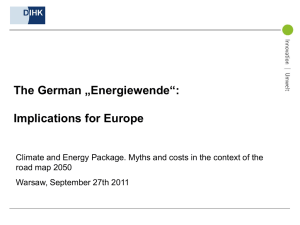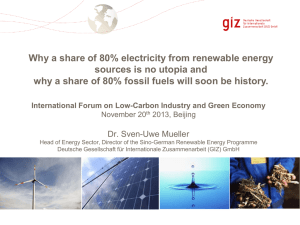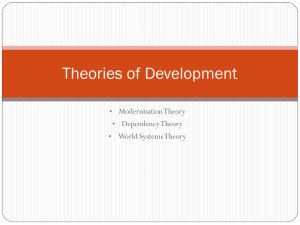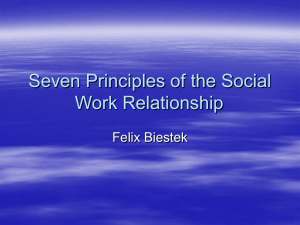Energiewende - Broen til framtiden
advertisement
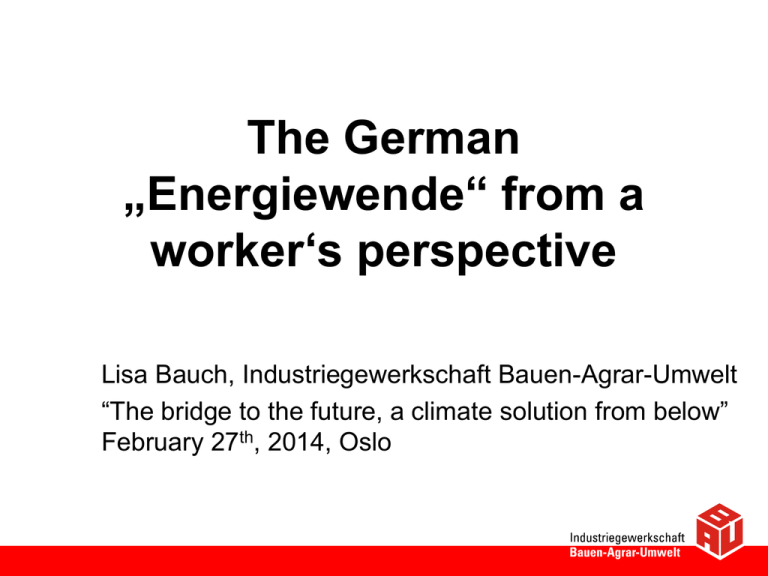
The German „Energiewende“ from a worker‘s perspective Lisa Bauch, Industriegewerkschaft Bauen-Agrar-Umwelt “The bridge to the future, a climate solution from below” February 27th, 2014, Oslo What is the ‚Energiewende‘? Germany is only average when it comes to ecology. - For the installation of renewable energies Germany is average. - Efficiency effects are slowing down since 2010. - GHG Emissions are decreasing slowlier and even started to rise again 2013. - Compared to the 28 member states Germany is only on level 10 when it comes to ecology. So, why is the Energiewende worth talking about? Source: Interview with WifO. Frankfurter Rundschau, 7.1.2013 What is the ‚Energiewende‘? A highly industry–based economy tries to radically change its energy supply system by switching from fossil fuels including nuclear power to renewable energies by reducing the power consumption This is to be realized by the Energiewende a package of different policies, regulations, and laws a clear timeline with targets and concrete actions 93 % of the citizen support this. What is the ‚Energiewende‘? Package of policies, regulations, and laws Programme for the retrofitting of buildings Research and education Less energy use Increase renewables … Industry Electricity Emission reduction 2020: -40% 2030: -55% 2050: -85-95% Klima-Allianz, 2012 Mobiltiy Heating What is the ‚Energiewende‘? Change of technology Phaseout of fossile energies Phase out of nuclear power until 2022 Phaseout of coal power until 2050 (?) Subsitution by renewables 25 % in electricity consumption in 2013 12% in overall energy consumption The EEG – The renewable Energy Act Need for reducing energy consumption! What is the ‚Energiewende‘? Eco-taxes The workers‘ perspective Driver for socio-ecological modernisation From employment against environmental protection towards Employment through environmental protection The workers‘ perspective Energiewende is seen as a driver for a socio-ecological modernisation … … in which industry and craft sector are main actors (or have to become). …from which they benefit enourmously. A workers‘ perspective Energiewende is seen as a driver for a socio-ecological modernisation … …which sets free large investments and generates turnover Investment in renewable energies Turnover with renewable energies 2004: 8,8 bill. Euro 2004: 12 bill. Euro 2012: 19,5 bill Euro 2012: 50 bill. Euro A workers‘ perspective …which creates employment 2012: 377.800 jobs Source: German Ministry of Environment, 2013 Energiewende is seen as a driver for a socio-ecological modernisation … A worker‘s perspective Energiewende is seen as a driver for a socio-ecological modernisation … …which contributes to a different ownership structure in the energy system A worker‘s perspective What do unions do to support the Energiewende Source: © deutsche-handwerks-zeitung.de 2014 Alliance for Work and Environment Retrofit programme for buildings, 1998-… A worker‘s perspective Alliance for Work and Environment Source: © deutsche-handwerks-zeitung.de 2014 f.ex. „Alliance for Work and Environment“, 1998-… Retrofit programme for buildings 2006 – 2010: 900.000 credits with a volume of 36 bill. Euro 75 bill. Euro of Investments. 2,4 mio. retrofit appartements on energy efficient standards 4,7 t CO2 – emmission reduction /year. 340.000 work places maintained and created/year A worker‘s perspective What do unions do to support the Energiewende Energy Efficiency by worker‘s participation Source: © deutsche-handwerks-zeitung.de 2014 New training profiles for green jobs Green and decent jobs Dialogue with civil society A worker‘s perspective Five bottlenecks Storage Grids Investment Knowhow Acceptance Energiewende Lessons learned Energy transition is possible Clear framework for investments We have to do it together ! Participation, inclusion, sharing burdens and profits Think European (European Marshall Plan) Thank you for your attention !
